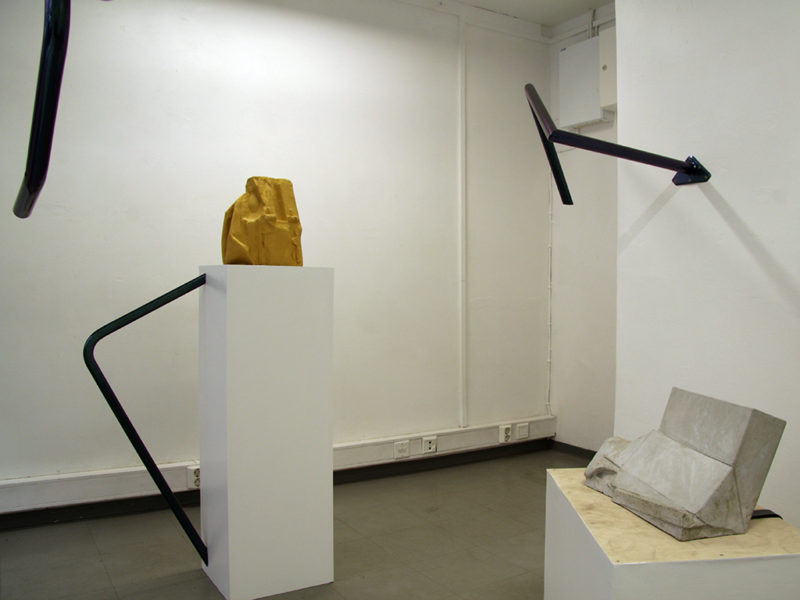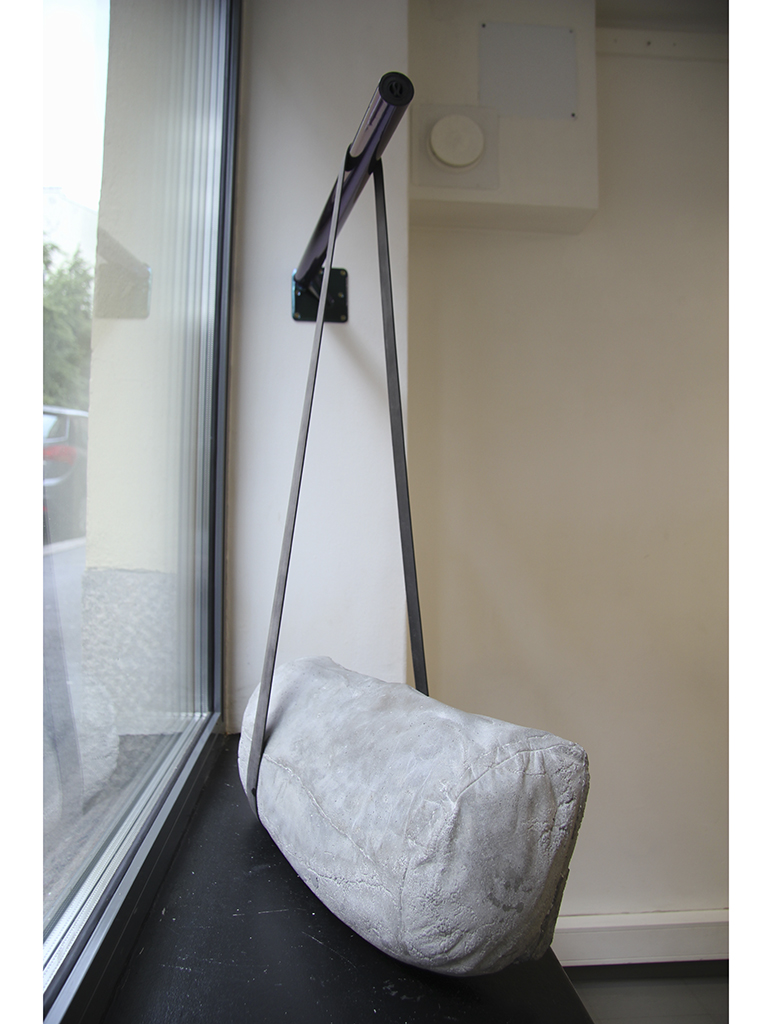29 Sep 2016
Interview
The Breakfast Club: Tiina Raitanen on Render

On August 31st, some twenty artists and art professionals gathered at the office of Frame (Frame Contemporary Art Finland), first thing in the morning, to discuss the work of HIAP alumna Tiina Raitanen. These morning coffees, organised by HIAP and Frame, focus on one work by one artist at a time, and they offer a platform for casual, friendly conversation. Introducing the work of Tiina Raitanen and especially her piece titled Render, was curator Hanna Ohtonen. Together the two discussed the piece thoroughly, projecting images and offering ideas for further consideration.
Tiina’s installation piece Render (15. – 23.6.2016, Third Space) consisted of three concrete and jesmonite sculptures, painted table and chair legs, rubber bands and plywood plinths. The sculptures were created by combining rubbish and other found objects into one unrecognisable form, that was then cast into either concrete or jesmonite. The rubber bands and plinths are also mostly found or recycled. All these elements combined create an installation that gives a new life and a new purpose to discarded objects.
The installation and the sculptures that comprise it are still. However, there seem to be hints of active movement in the way that the objects have been installed. The rubber bands appear to be pulling the sculptures upwards, and the table legs appear almost mobile. There is also a contrast within the materials themselves. The materials used are mostly plastic. The forms are cast in concrete and jesmonite, which are both construction materials, manmade. Yet the forms that Tiina creates are almost organic in their smoothness.
While Tiina’s installations have no narrative structure within them, they still present some elements of seriality and repetition. There are recurrent themes and frequent details in Tiina’s work. Her installations are created within specific spaces, taking the quirks of each space into consideration. The installations have no recommended direction in which to read the elements, however they do tend to appear as a segmented whole which requires the viewer to take in the whole in steps.
Tiina is interested in in-between places, such as building sites and landfills. She often walks in such places, looking for details that other people have overlooked. The temporality of those places and the rubbish she finds there make for an interesting subject matter, once turned into sculpture, which is by nature permanent.
There is a great contrast between the temporality of human waste and the permanence of concrete sculpture. Sculpture tends to be viewed as everlasting, and creating an object that is eternal out of something that is momentary, creates a tension. That tension results in what Tiina describes as the fossils of the future; the idea that, upon a time in the future, scientists will be looking at objects from this era as time-capsules, as fossils describing past times, our times.
It is a terrifying idea, that for the first time in the history of the world, humans and human waste are now impacting the earth and its ecosystems permanently. Tiina’s sculptures draw attention to that waste, all the plastic and discarded, disposable materials that will soon form an extra layer on the earth’s surface. Although the Anthropocene is not something that can now be prevented, Tiina feels that the very least she can do is help give a new purpose to some of that waste.
Some parts of the sculptures were found while on residence in Paris and Wiepersdorf, near Berlin. Tiina believes that residencies are an excellent way to boost one’s motivation and creativity, as the rhythm of work changes completely while abroad. The same themes follow, but the mode of working becomes different and more inspired. Of course, the results of the Anthropocene and Tiina’s need to work with the subject matter exist as much in Paris as they do in Helsinki.
Tiina is an avid learner. She tries to learn something new for every project that she gets involved with. Usually, this means playing around with new materials, for example jesmonite, the use of which she perfected for Render. However, sometimes it can mean getting involved with a new hobby. While holidaying in Bali, she learned how to surf. The experience was fantastic, yet the contrast between the cleanliness of the waves further out in the ocean, and the dirty shores covered in plastic made Tiina even more certain that her practice is worthwhile.

TA: Tiina, how do you feel sculpture can consider concepts of time and narration?
TR: A sculpture is often interpreted as being very still in time, even though it may have taken a long time to produce. The time spent working on the sculpture is visible in the materials and the technique used in its production. The materials often reflect time themselves. There are materials which are viewed as being trendy, and others, which are considered timeless and eternal, such as bronze or stone. New material innovations are making their way into sculpture.
In my own works, time is also present in the objects that give the sculptures their shape and form. The work process erases old interpretations and creates new meaning, giving my sculptures their own place in a chain of time and memory. I save something, but what and how much? The meaning merges with the rest of the piece and the sculpture transforms.
Also the way in which I position the installation parts in the gallery space creates temporal and narrative layers. The viewer’s gaze and their own understanding of the piece create unique narratives between the parts of the installation and between the materials used. I feel that my works are also mysterious; they hold certain narrative elements, yet don’t want to reveal too much about themselves.
Read more on Tiina’s work: http://tiinaraitanen.net
Render: http://www.th1rdspac3.com/render.html
Third Space: http://www.th1rdspac3.com
Text by Tessa Aarniosuo based on The Breakfast Club (31.8.2016) and an interview (13.9.2016).
Images courtesy of the artist.
